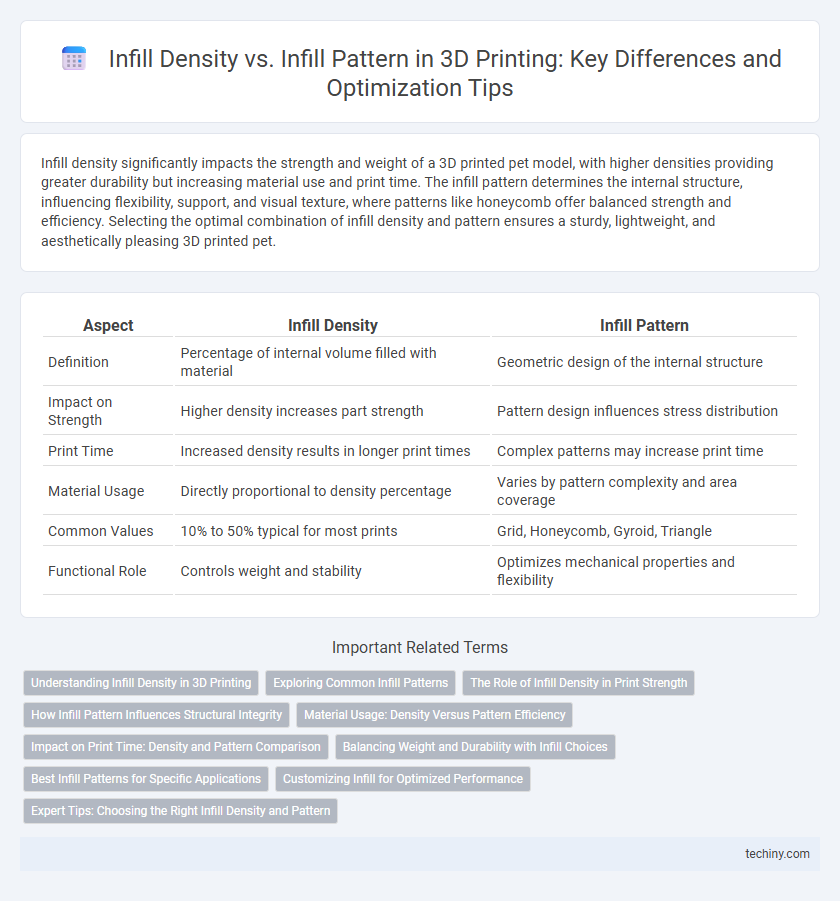Infill density significantly impacts the strength and weight of a 3D printed pet model, with higher densities providing greater durability but increasing material use and print time. The infill pattern determines the internal structure, influencing flexibility, support, and visual texture, where patterns like honeycomb offer balanced strength and efficiency. Selecting the optimal combination of infill density and pattern ensures a sturdy, lightweight, and aesthetically pleasing 3D printed pet.
Table of Comparison
| Aspect | Infill Density | Infill Pattern |
|---|---|---|
| Definition | Percentage of internal volume filled with material | Geometric design of the internal structure |
| Impact on Strength | Higher density increases part strength | Pattern design influences stress distribution |
| Print Time | Increased density results in longer print times | Complex patterns may increase print time |
| Material Usage | Directly proportional to density percentage | Varies by pattern complexity and area coverage |
| Common Values | 10% to 50% typical for most prints | Grid, Honeycomb, Gyroid, Triangle |
| Functional Role | Controls weight and stability | Optimizes mechanical properties and flexibility |
Understanding Infill Density in 3D Printing
Infill density in 3D printing directly influences the strength, weight, and material consumption of the printed object, typically ranging from 0% (hollow) to 100% (solid). Higher infill densities provide enhanced structural integrity but increase print time and filament usage, while lower densities reduce material costs and weight but may compromise durability. Understanding the optimal infill density is crucial for balancing mechanical performance and resource efficiency in various 3D printing applications.
Exploring Common Infill Patterns
Common infill patterns in 3D printing, such as grid, honeycomb, and gyroid, directly impact the strength, weight, and print time of a model. Grid infill offers balanced rigidity and faster prints, while honeycomb provides enhanced strength with moderate material usage. Gyroid infill delivers excellent strength-to-weight ratio and flexibility, making it suitable for functional parts requiring toughness and lightweight properties.
The Role of Infill Density in Print Strength
Infill density plays a crucial role in determining the overall strength and durability of 3D printed objects, directly impacting load-bearing capacity and structural integrity. Higher infill densities provide increased internal support, resulting in stronger prints capable of withstanding greater mechanical stress. In contrast, lower infill density reduces material usage and print time but compromises strength, making density selection vital for balancing performance with efficiency.
How Infill Pattern Influences Structural Integrity
Infill pattern significantly influences the structural integrity of 3D printed objects by distributing stress and strain strategically throughout the model. Patterns like honeycomb and grid enhance strength and load-bearing capacity by creating consistent support frameworks, whereas simpler patterns such as lines provide less resistance to deformation. Selecting the appropriate infill pattern optimizes mechanical performance and durability based on the specific application and material properties.
Material Usage: Density Versus Pattern Efficiency
Infill density directly impacts material consumption by determining how much filament fills the interior of a 3D print, with higher densities using more material but increasing strength. Infill patterns, such as honeycomb or grid, optimize material distribution, allowing similar mechanical properties at lower densities by enhancing structural efficiency. Choosing the right combination of infill density and pattern balances material usage and print strength, reducing waste while maintaining durability.
Impact on Print Time: Density and Pattern Comparison
Infill density significantly affects print time, with higher percentages increasing the duration due to more material deposition. Infill patterns like honeycomb or gyroid offer optimized strength with moderate print times, whereas solid or grid patterns generally result in faster prints but may compromise structural integrity. Choosing the right combination of infill density and pattern balances print speed and part durability in 3D printing projects.
Balancing Weight and Durability with Infill Choices
Infill density directly impacts the weight and strength of 3D printed parts, with higher densities offering increased durability but added weight. Selecting the right infill pattern, such as honeycomb or grid, can optimize structural integrity while minimizing material use, enhancing overall print efficiency. Balancing infill density and pattern ensures a tailored approach to achieve desired performance criteria without unnecessary weight or material expenditure.
Best Infill Patterns for Specific Applications
In 3D printing, choosing the best infill pattern depends on the application's mechanical requirements and material efficiency; grid and triangular patterns offer superior strength for functional parts, while honeycomb and gyroid patterns provide excellent balance between weight and durability. For aesthetic or lightweight models, line and concentric infill patterns minimize material use without compromising print speed. Optimizing infill density alongside pattern selection enhances structural integrity and reduces print time, crucial for cost-effective manufacturing.
Customizing Infill for Optimized Performance
Customizing infill density and infill pattern are crucial for optimizing 3D print performance, balancing strength, weight, and material usage. Higher infill density enhances structural integrity but increases print time and material consumption, while strategic infill patterns like honeycomb or gyroid offer efficient load distribution with reduced weight. Selecting the optimal combination tailored to specific functional requirements improves durability and print efficiency in applications ranging from prototyping to functional parts.
Expert Tips: Choosing the Right Infill Density and Pattern
Selecting the optimal infill density and pattern is crucial for balancing strength, weight, and print time in 3D printing. Experts recommend using higher infill densities like 50% or more for functional parts requiring durability, while lower densities around 10-20% suffice for prototypes or aesthetic models. Common patterns like grid or honeycomb provide versatile strength distribution, but complex geometries benefit from gyroid infill for enhanced stress resistance and material efficiency.
Infill Density vs Infill Pattern Infographic

 techiny.com
techiny.com